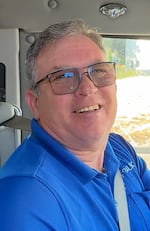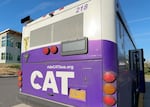Editor’s note: This is the first in “Stop Requested,” OPB’s multi-part series about a journey to the corners of Oregon by public transit.

Gene Jones drove for TriMet for 18 years and retired in the early 2000s. He started driving for Columbia Area Transit a few months ago because he wanted something to do in the winter. “I enjoy people, it’s a fun deal,” he said.
Prakruti Bhatt / OPB
Fourteen days, and more than 30 buses — OPB’s Lillian Karabaic and Prakruti Bhatt experience the joys and difficulties of rural transit ... and talk to many people along the way.

"Stop Requested" is a journey by public transit to all the communities that OPB says on the radio every hour. This is a map of the route which took 14 days and 38 buses to complete.
Lillian Karabaic / OPB
Friday, Sept. 13
Bus 1: The Dalles Transit Center > Hood River Transit Center
Hood River LINK, $10, 32.4 miles
We start our trip in The Dalles on The LINK bus. This transit agency used to be entirely medical rides, generally taking people into Portland for medical appointments and procedures. But in 2018, they used state funds to expand their service to include the intercity transit and two deviated fixed routes — that’s a type of bus where you can schedule a pick-up or drop-off within a small distance of the standard route. We’re picked up at our hotel instead of walking a quarter-mile to the shopping center.
Our driver is Fred Bergren, who’s been driving for The LINK for almost nine years. A new driver just started who’s also called Fred and it’s creating some confusion on the dispatch radio as we get in.
“I might have to change my name to Chad” said Bergren, “I told them to not call me the old Fred anymore.” Instead of Old Fred, we suggest “OG Fred” or “Seasoned Fred.”

Fred Bergren, who’s been driving for The LINK in Hood River for almost nine years. A new driver just started who’s also called Fred and it’s creating some confusion on the dispatch radio. “I might have to change my name to Chad” said Bergren, “I told them to not call me the old Fred anymore.”
Prakruti Bhatt / OPB
On the bus with us are Lewis and Debbie Ambers, who are riding to Hood River to pick up prescriptions at Walmart and visit friends. Debbie Ambers grew up in Hood river. Lewis Ambers is from North Dakota but worked at the Port of Hood River for 20 years.
To Debbie’s chagrin, Lewis often had to climb on top of the Hood River bridge and jump off the side. She says she didn’t want to know about it until he got off work. Lewis Ambers says it’s not that scary with precautions, “You’ve got triple safety ropes, you’re good,” he says.
Lewis Ambers is proud of his work at the port getting the bridge lift mechanisms automated and updated. He pulls out a news clipping about it from his wallet. “I’m so proud of what I’ve done, I carried it with me.” He points to himself in the clipping.
One of his most memorable experiences working at the bridge was a horseback rider who was riding from Washington to California after being diagnosed with terminal cancer. “And he figured it’s going to be his last ride,” says Ambers. “So we escorted him across, gave the horse water, food and all that on. And talked to him for quite a while about it. Then he moved on and then we heard he passed away when he got down there. But he did what he wanted to do his last ride.”
Ambers also dealt with cancer, twice. He retired early after being diagnosed with non-Hodgkins lymphoma, at type of blood cancer that occurs when malignant cells form in the lymphatic system.
“I tried to fight through it working,” he says. “The doctor told me, ‘You have to take a choice. You‘ve got to either quit your job or ... you may pay the consequences of not making it.’ So I retired early and I actually got cancer twice, fought it twice. And I finally got rid of it.”
Bus 2: Hood River Transit Center > Gateway Transit Center, Portland
CAT Columbia Gorge Express, free transfer, 18.2 miles
We have just a few minutes to swap to the Columbia Gorge Express CAT (Columbia Area Transit) bus, which is already waiting at Hood River Transit Center, and will make a brief stop at Multnomah Falls, and Gateway Transit Center in east Portland.
This connection between Hood River LINK and Columbia Area Transit’s Columbia Gorge Express is part of a five-county transit alliance in the Mid-Columbia region. Thanks to a 2021 revamp, we are able to use the same “Gorge Pass” mobile tickets for both buses, and the schedules have been coordinated so riders can make connections. It works seamlessly as a rider. Our LINK bus pulls in behind the CAT bus, and we hop off and head straight into the other bus.

Columbia Area Transit, CAT, runs the Columbia Gorge Express bus from Gateway Transit Center in Portland to Hood River, with a stop at Multnomah Falls.
Prakruti Bhatt / OPB
Our driver, Gene Jones, drove for TriMet for 18 years and retired in the early 2000s. He started driving for CAT a few months ago because he wanted something to do in the winter. “I enjoy people, it’s a fun deal,” he said.
The CAT bus is larger than the Hood River LINK 14-passenger bus, with the size and the layout of a typical urban city bus. There‘re eight passengers riding, a mix of locals and tourists.
A rider gets on in Cascade Locks to ride to a 12-step meeting in Portland. We chat the whole way to Portland. He tells me he’s been sober for decades. He has his own car but likes to take the bus a few times a week to “keep in touch with reality.” He says it makes him a better sponsor to newly sober people.
Train 1: Gateway Transit Center > Portland Union Station
TriMet Green Line MAX, $2.80, 6.4 miles
We arrive at Gateway Transit Center right on schedule. We then have our choice of bus routes or light rail lines to get to Union Station in downtown Portland — the last time we’ll have so many options for the next two weeks. At Union Station, we’ll catch the bus to Astoria.
Saturday, Sept. 14
Bus 3: Portland Union Station > Astoria Transit Center
Oregon NorthWest POINT, $18, 107.7 miles
The NorthWest Oregon POINT bus is one of four long-distance coach routes subsidized by the Oregon Department of Transportation, or ODOT. POINT services are intended to fill gaps in the intercity transit network by running buses where a private operator isn’t financially viable.
The NorthWest POINT is a twice-daily large coach bus that will make the three-hour journey from Portland’s Union Station to Astoria for less than $20. It’s a cushy ride for that price, with slow, but functional, on-board Wi-Fi, a bathroom, and outlets to charge your phone. The ride passes quietly, with less than a dozen people on board. We cross over the coast range on a crisp fall day.
As we pull into the parking lot of Camp 18 Logging Museum outside of Seaside, another POINT bus pulls alongside us. Our driver gets out, taking her lunch box and bag, and points to the driver getting out of the other bus “She’ll get you the rest of the way!” The two drivers then swap buses.
Our new driver explains she’s based in Portland but has been staying in Astoria for five days while covering the route. “They send me over here, usually I stay for two days. But our guy who lives in Astoria is really sick.”
The ride is uneventful, except for a preschool-age kid on vacation with his mom who is convinced every stop since Cannon Beach is Astoria. He gets up out of his seat at each stop, running up and down the aisles shouting “Astoria! Astoria! Astoria!” The adults on the bus would giggle. The driver tries to calm him down, “Not yet! You’ll know it’s Astoria when you see pelicans.” And later “Are you going to take the trolley in Astoria?”
After an hour of false Astorias, his mom and the other passengers are just as ready to pull into Astoria as he is.
As we disembark at the Astoria Transit Center, the driver says “We finally made it to Astoria!” mimicking the boy’s excited shouts.
Bus 4: Astoria Transit Center > Seaside Cinema
Sunset Empire Transportation District Route 101, $1, 17 miles

OPB "Weekend Edition" host Lillian Karabaic, left, and another rider wait to board Route 101 in Astoria Transit Center. Sunset Empire Transportation District, which serves Astoria and Clatsop County, stopped services for a month 2023 due to a financial shortfall. They have returned after an infusion of cash but with reduced service.
Prakruti Bhatt / OPB
We have just half an hour to grab a snack at downtown Astoria’s food carts before we’re set to grab the weekend bus from Astoria to Cannon Beach. If we don’t catch the bus at 12:30 p.m., we’ll have to wait until 7:56 p.m. for the next run, which would cause our whole trip to reroute.
Clatsop County’s transit agency, Sunset Empire Transportation District, stopped service unexpectedly for a month in 2023 after a financial shortfall. When they returned, partially bailed out by ODOT funds, they brought back fewer routes.
There‘s a heavy, misty rain covering everything in Astoria as we wait in their quaint transit center. Video producer Prakruti Bhatt, who is along for this journey, describes it as “‘twilight’ weather”. Luckily, there are shelters in the transit center while we wait for the bus.

The view from the bus along Highway 101 between Seaside and Astoria.
Lillian Karabaic / OPB
Once we get on the bus, we meet a committed group of regular riders.
James from Astoria, who doesn’t provide his last name, is riding the Route 101 bus with his bike on the front rack. “I used to ride the bus exclusively for a bunch of years. And I really got to meet a lot of my neighbors,” he says.
“So for me, it was kind of like a huge spiritual experience getting to really get outside myself and chat with people. I live by myself so I really liked that sense of community and it’s absolutely hands-down the best place to get the best gossip. Like, everybody on the bus 100% knows what’s going on, what’s going down.
Bus 5: Seaside Cinema > Cannon Beach (Midtown)
Sunset Empire Transportation District Pacific Connector, $1, 9 miles

"It's like we're inside a cloud." A foggy Saturday as seen from the inside of the Sunset Empire Transportation District Route 101 bus, crossing Astoria-Megler Bridge. As seen on Sept. 14, 2024.
Prakruti Bhatt / OPB
The rain gets worse as we head down Highway 101 until it is almost as though we’re inside a cloud. The bus windows are completely enveloped in gray, with barely any visibility.
A hiker visiting from Boulder, Colorado, flags down the bus, saying she‘s just happy to be somewhere dry instead of walking in the rain with a large backpack. “It was great the first eight miles — it was perfect! It’s a rainforest. It was gorgeous,” she says. But after hiking along Highway 101 while the rain got worse, “I checked the schedule and said ‘Oh my God! The bus is coming right now!’” she says.
As she disembarks in Seaside, a regular rider shouts after her, “Please try to stay dry.”
Bus 6: Cannon Beach (Midtown) > Tillamook Transit Center
Tillamook County Route 3, $1, 42.9 miles

Haystack Rock in Cannon Beach on Sept. 14, 2024.
Prakruti Bhatt / OPB
We have about 90 minutes between buses in Cannon Beach to grab lunch before catching the Tillamook County Route 3 bus. All along the Oregon Coast, bus service is less frequent than it was before COVID-19. We have to race today to get down to Lincoln City, because Tillamook County Transportation District ended Sunday service at the beginning of the summer due to a shortage of drivers. Many riders express worry that service would get even less frequent.
General Manager Brian Vitulli says the transportation district hoped to bring back Sunday service but keeps coming up short on drivers due to turnover. In addition to taking awhile to train drivers, Vitulli says it’s difficult to recruit drivers to move out to Tillamook because of the high cost of housing on the coast.

James Carlile has been driving for Tillamook County Transit District for about a year, and likes the work and getting to know his riders. He says it's almost like he doesn't go to work at all, as he used to commute the same distance as he now drives.
Prakruti Bhatt / OPB
Our driver for the Tillamook County Transit Center Route 3 is James Carlile. He started driving for Tillamook County about a year ago after doing agricultural work. He says his favorite part of driving is how quickly the shifts go by. He used to commute from Tillamook to Lincoln City for work. Now, driving down to Lincoln City is the work. He handles the bus around the highway’s curves and through the fog with ease and we pull into pungent Tillamook as the sun is setting.
Bus 7: Tillamook Transit Center > Safeway, Lincoln City
Tillamook County Route 4, $1, 49.2 miles

The inside of the Tillamook County Route 3 bus. All along the Oregon Coast, bus service is less frequent than it was before COVID-19. We have to race today to get down to Lincoln City, because Tillamook County Transit District ended Sunday service at the beginning of the summer because they didn’t have enough drivers. Many riders express worry that service would get even less frequent.
Prakruti Bhatt / OPB
After a quick dinner stop in Tillamook, we get back on the same bus with the same driver, James Carlile, but this time for Route 4. Many of the same riders get back on. “Did you get the new job?” Carlile asks one of the boarding riders. “No, they rejected me for a gaming license,” the rider replies.
Carlile knows all his regular riders’ schedules and workplaces. They form a little community within the bus. One rider greets everyone as they get in and off and knows all the routes, and I joke that she is the “Mayor of Tillamook County Transportation District.” Another rider agrees that she might be.

En route to Tillamook, one rider greets everyone as they gets in and off and knew all the routes. OPB "Weekend Edition" Host Lillian Karabaic dubs her “Mayor of Tillamook County Transit District.”
Prakruti Bhatt / OPB
The bus is a loud, older bus. It has an old-school transparent farebox that looks to be out of a different decade. While it’s a friendly ride, I wouldn’t describe the seats as comfortable.
Carlile says it has more than 300,000 miles on the odometer. Because of the long distances in Tillamook County’s routes, especially the discontinued 60X route from Lincoln City to Salem, their buses rack up a lot of miles.
They recently “surplused” two larger buses — one with 713,000 miles and one with 678,000 miles. General Manager Brian Vitulli says the hope is that those buses will be able to be donated to the Confederated Tribes of Grand Ronde, so that they can pick up operations on the 60X route.
It’s fully dark outside when we get out at the Safeway in Lincoln City, and the road is enveloped in fog. We’re done with buses for the night, other than a quick loop on the Chinook Winds Casino shuttle service.
Sunday, Sept. 15
Bus 8: Safeway, Lincoln City > Newport City Hall
Lincoln County North Route, $3, 31.8 miles

The map of the first two days of "Stop Requested" from The Dalles to Lincoln City. All together the 235 mile route includs seven buses, one train and six transit agencies.
Lillian Karabaic / OPB
After staying in Lincoln City overnight, we catch the early morning bus south to Newport. Even though it’s before 7 a.m. on a Sunday, the other riders are chatty, and most of them know one another. One rider greets everyone as they get on and gives the local news updates, which is sad news this morning. “Did you know that guy named Richard? Did you hear he passed away?”
As we drive down the coast, we pick up more riders commuting to work. One of them is Cooper Martin. Martin rides the Lincoln County North and South route every weekend to work in South Beach.
Martin says the bus has made him feel more connected to the community after moving from Florida in January. “I pretty much traveled almost this entire bus line and it’s very nice. You can get anywhere in the coast.”
Martin says that, despite the buses’ accessibility, “some people kind of get persuaded away from [taking it] because they’re like, ‘Oh, they kind of see people, you know, maybe at their lowest they’ve ever been,’” says Martin. “But you kind of get a big bite of all of society.”
However, Martin is moving inland to Corvallis after his seasonal ranger work is wrapped, partially because the bus schedules are better there and housing is cheaper. Better transit “means more convenient times,” says Martin. “Because when I get off work I have to wait an hour for the bus back home, and that eats up a lot of my time,” he says.
Eventually, we arrive at Newport’s city hall and wait for our next bus, the Coast-to-Valley Express.

Next tomorrow: We’ll also go inland to Corvallis, in search of more frequent transit. Read part two here.
